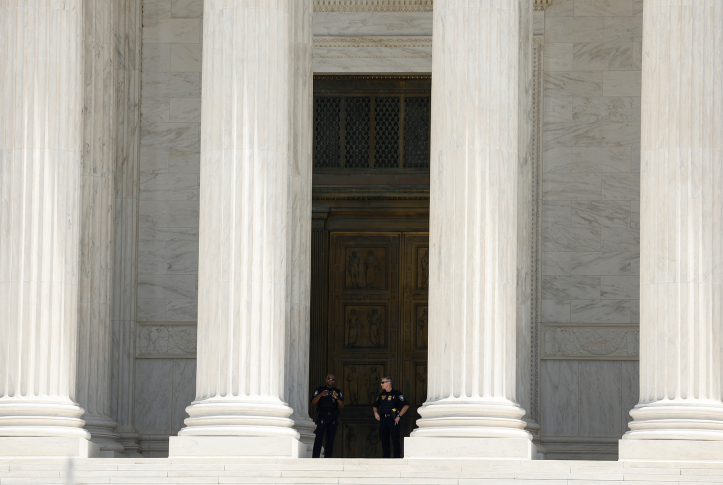The Supreme Court’s decision on June 24 in Dobbs v. Jackson Women’s Health Organization came as no surprise, given the widely publicized leaked draft majority opinion. Moreover, the Court had already allowed Texas to ban abortion after approximately six weeks, suggesting a more dramatic decision was on the way. Yet the ruling still shocked; its impact will be felt across every aspect of American society.
Never in its history has the Supreme Court ended a basic constitutional protection. To be sure, following its seminal 1973 decision in Roe v. Wade, which established abortion as a fundamental right, the Court narrowed its scope in Planned Parenthood v. Casey. But Casey preserved Roe’s core principle by prohibiting states from imposing previability abortion bans. Dobbs swept this right away.
Below we summarize the key points in the majority, concurring, and dissenting Dobbs opinions. A second post will flag some of the most pressing follow-on legal issues.
The Majority Opinion
Writing for a five-member majority, Justice Alito (along with Justices Barrett, Gorsuch, Kavanaugh, and Thomas) portrayed the decision as simply ending 50 years of judicial interference that had found rights where none existed and erected barriers to state regulation. He wrote, “the Constitution makes no reference to abortion and no such right is implicitly protected by any constitutional provision. This Court cannot bring about the permanent resolution of a rancorous national controversy simply by dictating a settlement and telling the people to move on.” The majority concluded that the right to abortion was nothing more than a manufactured constitutional right — an abuse of the Fourteenth Amendment’s “liberty” protection — and that the parameters of the Fourteenth Amendment’s protection are set by the scope of rights that existed in 1868 when the amendment was adopted.
The majority held that in finding a right to abortion, the Roe and Casey Courts had legislated from the bench, elevating a medical procedure to constitutionally protected status. In so doing, it said, the previous Courts — in a misguided effort — had concocted a regulatory regime that exempted abortion from states’ historical power to regulate medical care and had mistakenly treated access to abortion as an extension of other constitutional liberty and privacy interests. The majority contended that abortion protections lacked any basis in historical fact since abortion bans were widespread up to the time of Roe. Excising the constitutional protection of abortion, Alito wrote, was a “neutral” action by the Court that would return abortion regulation to the states, where the democratic process could set acceptable bounds.
Stare decisis — that is, respect for precedent — was not a problem, the Court held, since it has long recognized the need to overturn erroneous precedents, such as Plessy v. Ferguson, which for a half century enshrined “separate but equal” as lawful until it was overturned by Brown v. Board of Education. Furthermore, the majority professed no concern with upending societywide reliance on the right to abortion, since safe and effective contraception is widely available. (Although readers may recall that Alito authored the Court’s opinion in Burwell v. Hobby Lobby Stores, which found religious employers could refuse to comply with the Affordable Care Act’s contraceptive guarantee.) Furthermore, he concluded, women have the ability today to pursue the life they choose even with children.
Chief Justice Roberts’s Concurrence in the Judgment
Notably, the Chief Justice did not sign the majority opinion. He concurred in the Court’s judgment upholding Mississippi’s 15-week abortion prohibition — the specific law challenged in Dobbs — but he would not have fully overturned Roe. Concurring separately, he argued for a “more measured course” that would have discarded Casey’s framework, which had recognized a right to choose up to the point a fetus is viable. He would instead have preserved only a “reasonable opportunity” (left to subsequent litigation to define) for women to choose abortion. The majority opinion, in his view, smacked of the same sort of judicial overreach inherent in Roe and Casey.
Justice Kavanaugh’s Concurrence
Justice Kavanaugh, concurring, stressed the Court’s neutral and limited position. Kavanaugh contended that the only right touched by the Court was the right to abortion; other Fourteenth Amendment liberty and privacy rights remained undisturbed. Even as he asserted that the Court simply was returning regulation of abortion to the democratic process, he also argued (somewhat inconsistently given the scope of the majority opinion) that there are constitutional limits to the regulation of abortion such as a state bans on interstate travel for abortion.
Justice Thomas’s Concurrence
In his concurrence, Justice Thomas gave no reassurances that the Court would stop at abortion. He openly called on the Court to reconsider all cases that rely on the same type of substantive due process rights found in Roe. Specifically, he pointed to prior Court decisions that protect the right to access contraceptives, the right of same-sex couples to engage in intimacy, and marriage equality. These decisions, he argued, are “demonstrably erroneous” and should be overruled.
Justice Breyer’s Dissenting Opinion
In a lengthy, passionate dissent — one of his last before retirement — Justice Breyer, joined by Justices Kagan and Sotomayor, called out the majority for hewing to an 1868 concept of rights in defining the scope of the Fourteenth Amendment. He wrote that this approach (also followed in this week’s case involving gun laws) is contrary to the dynamic approach the Court has taken in the past in expanding the concept of individual liberty. This expansive approach, Justice Breyer argued, is consistent with the Constitution’s use of open-ended concepts such as liberty and due process, which the framers presumed would be fleshed out over time. Notably, he pointed out, the majority’s approach ignores the fact that women in 1868 had no independent legal status apart from their husbands’.
Breyer also rejected the majority’s approach to stare decisis and precedent, taking the position that overruling precedent is legitimate only if the facts or the law have changed, neither of which is true here. Indeed, before casting precedent aside, it is of the utmost importance to consider the extent to which society has come to rely on legal precedent, especially a decision that so profoundly affects women and men as they plan their lives, careers, intimate relationships, and families.
The dissent also pointedly explained how the Court’s decision in Dobbs could be used to overturn the decisions identified by Justice Thomas — and potentially others. No one, Justice Breyer stressed, should “be confident that today’s opinion will be the last of its kind.”
Finally, the dissent criticizes the decision as a power grab, noting that certain members of the American right wing have long “despised” Roe and Casey and, after taking over the Court, have gotten rid of them. The decision undermines the legitimacy of the Court and reduces it to yet another political branch.
And so, the nation enters a new world, in which the constitutional right to abortion is eliminated.






